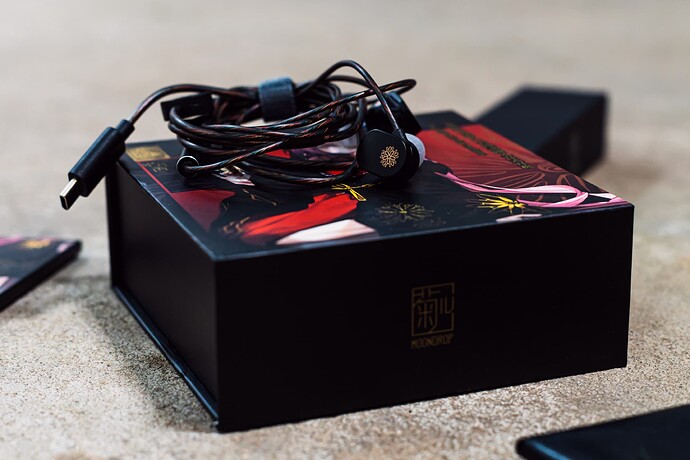Moondrop Jiu Review
INTRODUCTION AND DISCLAIMER:
The Moondrop Jiu is an in-ear monitor (IEM) with one 10mm titanium diaphragm dynamic driver in each housing. It is an upgraded version of the Moondrop Chu that utilizes onboard digital signal processing (DSP). It connects to transport devices with a USB-C connector. The Jiu retails for $24.99 at ShenzhenAudio. I received the Jiu from ShenzhenAudio in exchange for my review.
PACKAGING AND ACCESSORIES:
The Moondrop Jiu arrives in a square, black cardboard box with a magnetic lid adorned with an anime waifu illustration. The waifu appears to be the same character featured on the Moondrop Chu’s box. Technical specifications and a frequency response graph appear on the back. Within, the Jiu is secured in a black foam sheet. The package includes three pairs of Moondrop Spring Tips eartips (S, M, L) and the same small Moondrop-branded black pleather storage pouch included with the Moondrop LAN. This is a nicer case than the rough felt pouch included with the Chu. Also inside the box are a quality control pass chit, user manual and contact card linking to Moondrop’s Tencent QQ account.
BUILD QUALITY AND DESIGN:
The Moondrop Chu and Moondrop Jiu are nearly identical in physical form and appearance:
The Jiu’s finish is smooth with a shiny luster…The faceplates are oval-shaped…“L” and “R” indicators are also printed in copper adjacent to the cable entry sites. The nozzles have a lip to secure eartips, which is relatively novel for Moondrop IEMs and is greatly appreciated. The nozzles have saucer plate-style mesh coverings. There are two pinprick circular vents on the interior face of the IEM body.
The fixed cables are forward-swept and have hard rubber strain relief at the base. The cable is unbraided and uses a soft rubber sheath. The Y-split hardware is a hard rubber disk embossed with Moondrop logos on both sides. There is no chin-adjustment choker and the cable is moderately tangle-prone. The cable does not have preformed earguides but the Jiu comes with two optional soft plastic earguide attachments.
Instead of the fanned leaf design found on the Chu, the Jiu features small radial flower petals. The Jiu also has a cylindrical three-button microphone enclosure on the right side cable between the Y-split and the earpiece. Finally, instead of a 3.5mm jack, the Jiu has a USB-C connector with tough black plastic hardware. The Moondrop logo is engraved on one side of the connector cover.
COMFORT, FIT, AND ISOLATION:
The Moondrop Jiu is identical in comfort, fit, and isolation to the Moondrop Chu:
The Moondrop Jiu is intended to be worn cable-up. The nozzles have a shallow insertion depth. Given the relatively small size of the earpieces, the Jiu is very comfortable to wear for extended periods, but secureness of fit and isolation are slightly below average. The Jiu has minor driver flex.
MEASUREMENTS:
My measurements of the Moondrop Jiu can be found on my expanding squig.link database:
Moondrop Jiu — Squiglink by Bedrock Reviews
SOUND:
Like the Moondrop Chu, the Moondrop Jiu is tuned to Moondrop’s Virtual Diffusion Sound Field target. The Jiu is essentially a refinement of the Chu, using DSP to solve the Chu’s admittedly already minor shortcomings. Overall, the Jiu is largely identical to the Chu in terms of technical performance.
The Jiu’s biggest improvement is in its treble response. The Chu had an uneven treble response, front-loaded with lower treble energy and dipping noticeably in the mid-treble. This deprived the IEM of sparkle. The Jiu has a smoother, more even treble response that is reminiscent of some of Moondrop’s best IEMs. To achieve this, the presence region has been dialed back slightly and the mid-treble has been filled in, creating a steady slope from the ear gain apex at 3 kHz to 12 kHz. This reduction in the presence region also improves timbre of analog percussion, resulting in less compression. The Jiu retains the Chu’s excellent upper treble extension.
The Jiu has a hair more amplitude in the mid-bass region than the Chu, which heightens percussive impact. Finally, the Jiu makes a few small tweaks to the Chu’s lower midrange, adding presence between 300 Hz and 1 kHz and chiseling a step along the ear gain rise between 1 kHz and 1.5 kHz. These tweaks reduce the prominence of male vocals relative to midrange instrumentation. This reduces the prominence of male vocals compared to instrumentation, making them less shouty but less distinct as well. It is ultimately a matter of subjective preference as to whether or not this is an improvement from the Chu.
NOISE FLOOR:
The Moondrop Jiu does have a noise floor that becomes more audible during quiet sections of songs. Given my musical tastes, this did not detract from my enjoyment of the Jiu. However, this may be a dealbreaker for listeners whose libraries consist primarily of more sparsely arranged music.
CLOSING WORDS:
The Moondrop Jiu could represent the budget IEM market’s next big leap thanks to its integrated DSP. This technology will allow manufacturers to squeeze out even better tunings from entry level drivers, adding to the amazing progress the market has made in recent years. If you already have the Chu, getting the Jiu is not a must. But if you’re curious about integrated DSP, you should give the Jiu a listen.
The Moondrop Jiu can be purchased below:
MOONDROP JIU USB-C Port 10 mm High Perfomance Dynamic Driver In-Ear E (shenzhenaudio.com)
